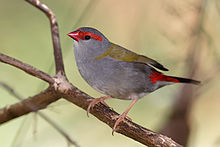Estrildidae
| Estrildid finches | |
|---|---|
 |
|
| Red-browed finch, Neochmia temporalis | |
| Scientific classification | |
| Kingdom: | Animalia |
| Phylum: | Chordata |
| Class: | Aves |
| Order: | Passeriformes |
| Suborder: | Passeri |
| Family: |
Estrildidae Illiger, 1811 |
| Genera | |
|
See text |
|
See text
The estrildid finches are small passerine birds of the Old World tropics and Australasia. They can be classified as the family Estrildidae (waxbills, munias and allies), or as a subfamily within the family Passeridae, which strictly defined comprises the Old World sparrows.
They are gregarious and often colonial seed eaters with short, thick, but pointed bills. They are all similar in structure and habits, but vary widely in plumage colours and patterns.
All the estrildids build large, domed nests and lay five to ten white eggs. Many species build roost nests. Some of the fire-finches and pytilias are hosts to the brood-parasitic indigobirds and whydahs, respectively.
Most are sensitive to cold and require warm, usually tropical, habitats, although a few, such as the eastern alpine mannikin, mountain firetail and red-browed finch, and the genus Stagonopleura, have adapted to the cooler climates of southern Australia and the highlands of New Guinea.
The smallest species of the family is the Shelley's oliveback (Nesocharis shelleyi) at a mere 8.3 centimetres (3.3 in), although the lightest species is the black-rumped waxbill (Estrilda troglodytes) at 6 g (0.21 oz). The largest species is the Java sparrow (Padda oryzivora), at 17 cm (6.7 in) and 25 g (0.88 oz).
The phylogeography and possible origin of estrildid finches have been studied. The following scheme may be useful to represent a hypothetical origin in India in the last and stronger Himalayas uplift (16.5 million years ago), when the monsoon rains regime was established in India (see figure). The conclusions from this study are:
...
Wikipedia
